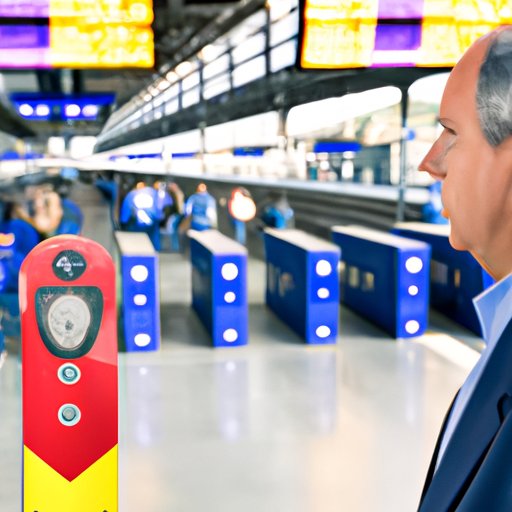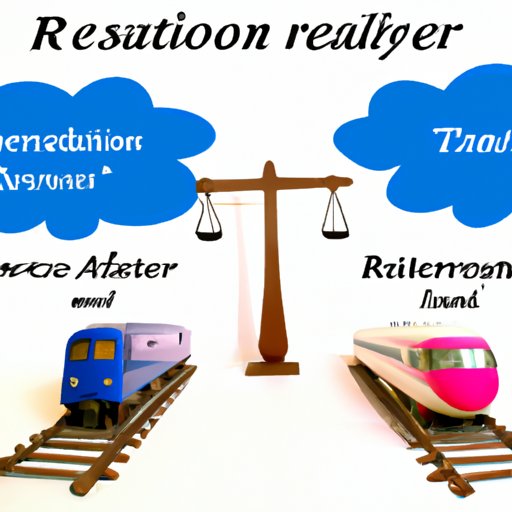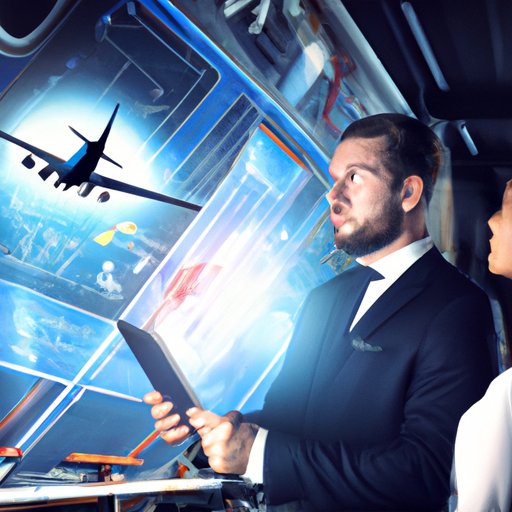Introduction
When it comes to deciding how to travel, there are a variety of factors to consider. Safety is often at the top of the list for many travelers, but is it safer to travel by plane or train? In this article, we will explore the safety records of air and rail travel, identify risk factors associated with both forms of transport, examine the security measures in place, evaluate advantages and disadvantages, and analyze cost and comfort considerations. We will also look at the latest technologies aimed at improving air and rail safety.
Comparing the Safety Records of Air and Rail Travel
The first step in determining which form of transport is safer is to examine the accident rates for air and rail travel. According to the International Air Transport Association (IATA), the global airline industry experienced its safest year on record in 2020, with an accident rate of 0.12 per million flights. This is significantly lower than the 0.44 average recorded between 2010 and 2019. By comparison, the European Railway Agency reported that the number of train accidents has been steadily declining since the early 2000s, with an average of 11.3 accidents per billion train-km in 2018.
It is important to note, however, that these figures do not tell the full story. Accidents are not always fatal; in fact, the vast majority of air and rail accidents result in no fatalities. When looking at the number of fatalities caused by air and rail accidents, the picture changes significantly. The IATA reported that 57 people were killed in aviation accidents in 2020, while the European Railway Agency reported that 1,542 people died in railway accidents in 2018. While this figure may seem high, it is important to note that the majority of these deaths were due to suicide, trespassing, and other non-accident related causes.
Human error is also a major factor when it comes to air and rail safety. According to the National Transportation Safety Board (NTSB), human error accounts for approximately 80% of all aviation accidents. Similarly, the European Railway Agency reported that human error was a contributing factor in more than half of all train accidents in 2018.
Examining Risk Factors for Air and Rail Travel
In addition to examining the safety records of air and rail travel, it is important to consider the most common risks associated with each form of transport. For air travel, the most significant risk factors include mechanical failure, weather conditions, and terrorism. Mechanical failure is the most common cause of accidents involving commercial aircraft, accounting for approximately half of all fatal crashes. Weather conditions, such as turbulence and icing, can also pose a serious risk to air travelers, particularly during takeoff and landing. Finally, terrorism remains a potential threat to air travelers, although the risk is relatively low compared to other forms of transport.
Risk factors associated with rail travel include collisions, derailments, and obstructions on the tracks. Collisions and derailments can occur due to mechanical failure, human error, or track defects. Obstructions on the tracks, such as fallen trees or debris, can also be a risk factor, particularly if they are not detected in time. Additionally, rail travel is vulnerable to the same weather-related risks as air travel, such as snow, ice, and flooding.

Evaluating the Security Measures in Place for Air and Rail Travel
Air and rail companies have implemented a range of security measures to ensure the safety of their passengers. Airlines have strict protocols in place for screening passengers and luggage prior to boarding, as well as for monitoring the cabin during the flight. Most airlines also employ armed sky marshals to provide additional security on board. Rail companies have implemented similar protocols, such as bag checks and metal detectors at stations, as well as regular patrols of trains and platforms.
New technologies, such as facial recognition and biometric scanning, are also being employed to improve security. These technologies can help to detect potential threats before they become a problem, as well as to monitor the movements of passengers during their journey. Additionally, advances in automation are providing increased safety for both air and rail travelers. Automated systems can be used to reduce the risk of human error, as well as to monitor the performance of equipment and alert operators of any potential problems.

Assessing the Advantages and Disadvantages of Air and Rail Travel
When assessing the relative safety of air and rail travel, it is important to consider the advantages and disadvantages of each form of transport. Air travel offers several benefits, such as speed and convenience. Flights are generally much faster than rail journeys, allowing passengers to reach their destination quickly and easily. Additionally, airports are typically located close to major cities, making them easy to access. However, air travel also has some drawbacks, such as long check-in times and the risk of delays due to weather or mechanical issues.
Rail travel has its own set of benefits, such as affordability and comfort. Tickets for train travel are usually much cheaper than those for air travel, making it a great option for budget-conscious travelers. Additionally, trains are often more comfortable than planes, with ample legroom and an opportunity to move around during the journey. However, rail travel also has some drawbacks, such as long journey times and limited availability of routes.
It is also important to consider the potential for increased safety through technological advances. New technologies, such as automated systems and advanced sensors, are being developed to improve the safety of air and rail travel. Automation can reduce the risk of human error, while advanced sensors can help to detect potential hazards before they become a problem. Additionally, new technologies can be used to monitor the performance of equipment and alert operators of any potential issues.
Analyzing Cost and Comfort Considerations for Air and Rail Travel
When comparing the safety of air and rail travel, it is also important to consider the cost and comfort levels of each form of transport. Air travel is typically more expensive than rail travel, although the cost can vary depending on the route and airline. Additionally, airlines often offer discounts and special offers, allowing passengers to save money on their tickets. In terms of comfort, planes tend to be more cramped than trains, with limited legroom and few options for movement. Trains, on the other hand, typically offer more space and greater comfort, as well as the chance to move around during the journey.
There are a number of ways to reduce the cost and increase the comfort of air and rail travel. Airlines often offer discounted fares for early bookings, as well as loyalty programs for frequent flyers. Additionally, passengers can take advantage of upgrades to business or first class, which offer more space and amenities. For rail travel, passengers can purchase advance tickets or use discount cards to save money. Additionally, passengers can opt for sleeper cars or cabins to enjoy greater comfort during longer journeys.

Exploring Innovations in Air and Rail Safety Technology
Finally, it is important to consider the latest technologies aimed at improving air and rail safety. Advances in automation are providing increased safety for both air and rail travelers. Automated systems can be used to reduce the risk of human error, as well as to monitor the performance of equipment and alert operators of any potential problems. Additionally, new technologies, such as facial recognition and biometric scanning, are being employed to improve security. These technologies can help to detect potential threats before they become a problem, as well as to monitor the movements of passengers during their journey.
Conclusion
Overall, both air and rail travel can be safe, provided that the necessary security measures are in place and the risks associated with each form of transport are properly managed. Air travel is typically faster and more convenient than rail travel, although it is also more expensive and can be subject to delays due to weather or mechanical issues. Rail travel is usually cheaper and more comfortable than air travel, although journey times can be much longer. Both forms of transport are vulnerable to the same risk factors, such as mechanical failure and weather conditions, and both can benefit from the latest technologies aimed at improving safety. Ultimately, the decision of which form of transport is safer depends on the individual traveler’s needs and preferences.
(Note: Is this article not meeting your expectations? Do you have knowledge or insights to share? Unlock new opportunities and expand your reach by joining our authors team. Click Registration to join us and share your expertise with our readers.)
